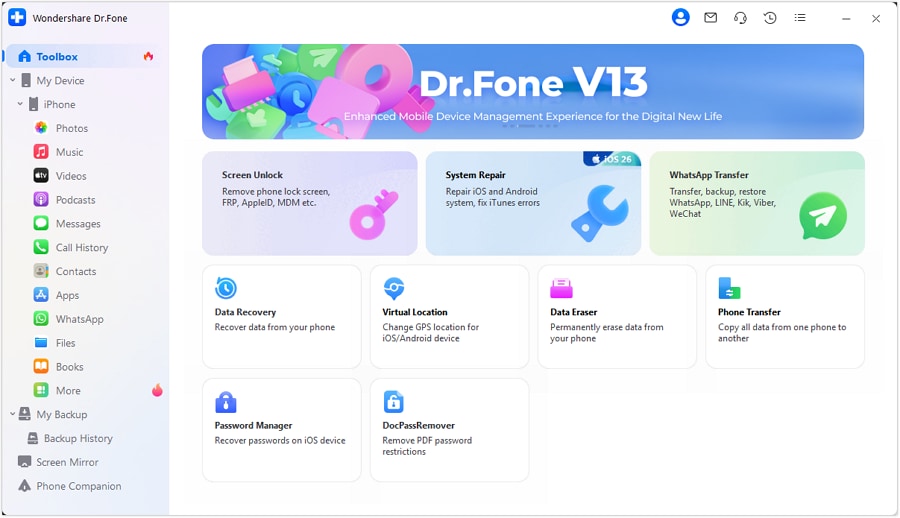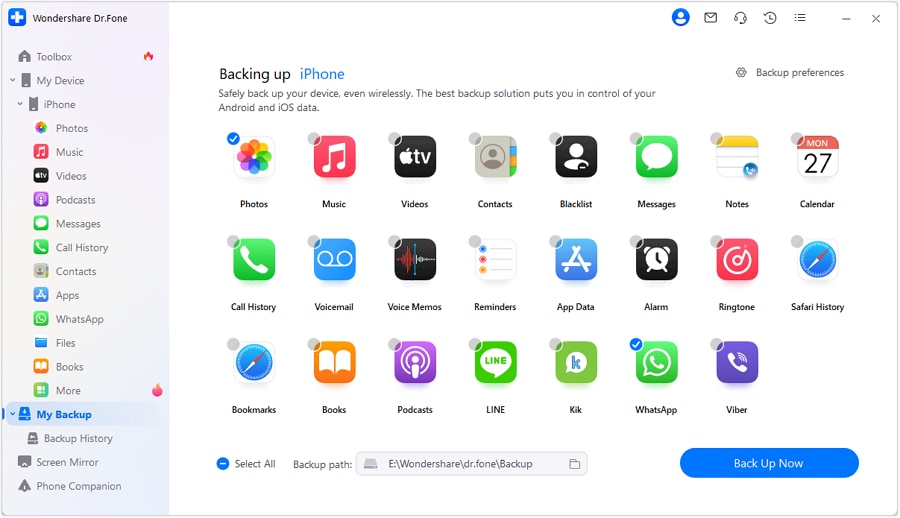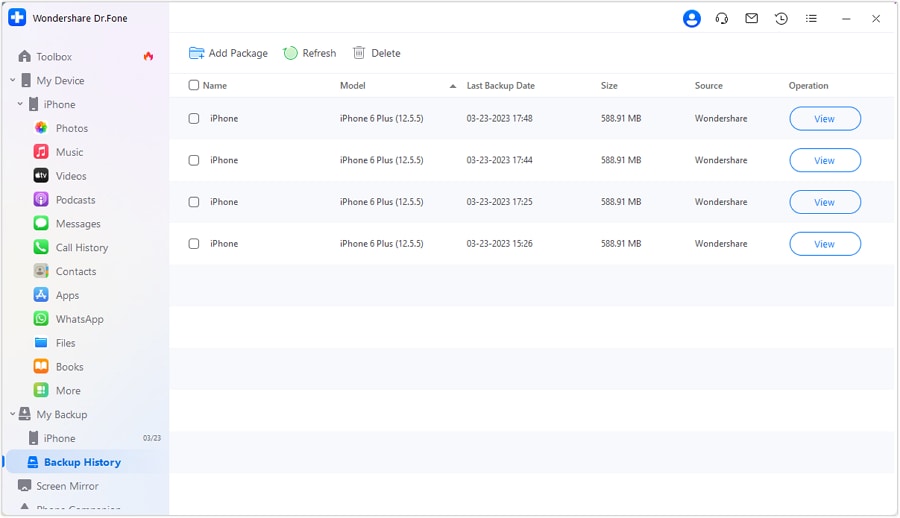
[Solved] 'iTunes Backup Session Failed' Error? 5 Fixes for 2025 [iPhone 17 Supported]
iTunes Manage
- iTunes Backup
- 1. Does iTunes Backup Photos
- 2. Forgot iTunes Backup Password
- 3. Fix iTunes Corrupt Backup
- 4. Fix iTunes Backup Session Failed
- 5. Change iTunes Backup Location
- 6. View Files on iTunes Backup
- 7. Backup WhatsApp Using iTunes
- 8. Top 5 iTunes Backup Managers
- 9. Top 6 Free iTunes Backup Extractor
- 10. Backup iMessage Without iTunes
- iTunes Restore
- 1. Restore Photos from iTunes Backup
- 2. Restore Data from iTunes Backup
- 3. Restore WhatsApp Using iTunes
- iTunes Rebuild
- 1. Transfer iPad Purchases to iTunes
- 2. Transfer iPad Music to iTunes
- 3. Transfer iPod Music to iTunes
- 4. Transfer Android Music to iTunes
- 5. Import Multiple Lyrics to iTunes
- iTunes Transfer
- 1. Sync iTunes Media to iCloud
- 2. Sync iTunes Media to Android
- 3. Transfer iTunes Music to iPod
- 4. Transfer iTunes Music to Flash Drive
- 5. Transfer iTunes Music to Android
- 6. Transfer iTunes Music to Google Play
- 7. Put iTunes Audiobooks to Android
- 8. Copy iTunes Playlists to Hard Drive
- 9. Move iTunes Library to PC / Mac
- 10. Export iPhone Contacts from iTunes
- 11. Export Playlist from iTunes
- iTunes Plugins/Alternatives
- 1. Top 3 iTunes Plugins
- 2. Top 20 Alternatives to iTunes
- 3. Top 3 iTunes Alternatives for Android
- 4. Top 5 iTunes Remote for Android
- iTunes Problems
- 1. Fix iTunes Error 11
- 2. Fix iTunes Error 1100
- 3. Fix iTunes Error 2005/2003
- 4. Locked Out Of iTunes
- 5. Forgot iTunes Password
- 6. Account Has Been Disabled in iTunes
- iTunes Tricks
- 1. Change the iTunes Skin
- 2. Use File Sharing in iTunes
- 3. Use Home Sharing in iTunes
- 4. Recover iPhone Data from iTunes
- 5. See iTunes Purchase History
- 6. Get Free iTunes Cards Legally
- 7. iTunes Visualizers Download
- 8. Watch iTunes Movie on Android
- 9. Update iTunes On Your Computer
- 10. Install iTunes on Windows / Mac
- ● Manage/transfer/recover data
- ● Unlock screen/activate/FRP lock
- ● Fix most iOS and Android issues
- Manage Now Manage Now Manage Now
Oct 24, 2025 • Filed to: Backup & Restore Solutions • Proven solutions
Dr.Fone Basic:
Better Control for Your Phone
Manage, transfer, back up, restore, and mirror your device
When it comes to creating a reliable backup on your iPhone, most users still rely on iTunes because of its one‑click simplicity. With iTunes, you can easily save all your important data, store backups directly on your computer, or sync them to iCloud for extra protection. However, many users run into issues like iPhone backup session failed or the frustrating iTunes backup session failed error. These errors are especially common with the latest models, and as the iPhone 17 comes packed with larger storage capacities, faster processors, and more advanced features, ensuring a smooth and error‑free backup is more important than ever.
Even with its convenience, iTunes backups aren’t error‑free. A common issue many users face is the iTunes backup session failed message, which usually appears when the backup process is interrupted or expires due to external factors. If you’ve experienced the iPhone backup session failed error, especially while backing up the new iPhone 17 with its expanded storage and advanced features, it can be frustrating.
In this article, we’re going to address a few effective techniques that’ll help you troubleshoot the “iTunes backup session failed” error.

Why does iTunes Backup Session fail in the First Place?
The truth is different factors, ranging from hardware-related issues to malware attack, can interrupt the iTunes backup session and prompt the said error instead. While there’s no definite answer on what causes the error, we have identified a few reasons that might be responsible for triggering the “iTunes backup session failed” issue. These reasons include:
- iTunes is corrupt: This is probably the most common reason for a failed backup session on iTunes. If a configuration file is missing on your PC, it’ll automatically corrupt the iTunes app and it won’t back up your data at all.
- Large Backup File: It’s important to understand that you can only back up limited data to iCloud, even if you’re using iTunes backup. In general, iCloud provides 5GB of free storage space. So, if your backup file is larger than 5GB, you’ll either have to buy additional cloud storage or delete a few items from the backup.
- Computer Error: As we mentioned earlier, even a hardware-related issue can cause an “iTunes backup session failed” error. This usually happens when your PC has run into an unexpected error or crash while iTunes was backing up the data.
- Antivirus: Even though it’s a pretty rare situation, there are many Antivirus programs that are configured to automatically interrupt backup/restore processes.
- Outdated iTunes Version: Finally, if you are running an outdated version of iTunes, you are most likely to run into the failed backup session issue.

Irrespective of the reason that caused the error, here are a few solutions that’ll help you troubleshoot it and continue backing up your data using iTunes without any interruption.
How to Deal With iTunes Backup Session Failed
Let’s start with some quick and effective fixes to resolve the iTunes backup session failed or iPhone backup session failed error. If these methods don’t solve the issue, we’ll also share a proven alternative to back up your data with a 100% success rate. This is especially useful for iPhone 17 users, as the device’s higher storage and advanced features make reliable backups more important than ever. Now, let’s dive into the first solution.
1. Update iTunes
Let’s start with something simple! If you haven’t updated the iTunes app on your laptop, make sure to update it to the latest version. You can easily update iTunes through the “App Store” on your Macbook.
Step 1 - Go to the App Store on your Macbook.
Step 2 - Tap the “Updates” option at the top of your screen.
Step 3 - If you see any iTunes updates, simply click “Install” to install them on your laptop.
Once iTunes is successfully updated, try creating a backup again and see if you encounter the “iTunes could not back up the iPhone because the backup session failed” error or not.
2. Restart Your Macbook and iPhone
If you are already using the latest iTunes version, the error may be caused due to a hardware related issue. In this case, you can simply reboot both the iPhone and the Macbook separately and check if it fixes the issue. Before rebooting the devices, however, make sure to disconnect your iPhone from the laptop.
3. Delete Files from the Backup
If you are trying to back up the data to your iCloud account, it’ll be imperative to keep the backup file size up to 5GB (maximum), unless you've bought additional cloud storage space. So, delete unnecessary files from the backup and try backing up data once again.
In case you still encounter the same “backup file too large” error, you can create the backup on your Macbook as well. In this case, however, make sure that your laptop has enough storage space to accommodate the backup file. You can easily free up some storage space on the Macbook by deleting a few unnecessary files.
4. Disable Antivirus Program
Since, Antivirus software can also interrupt the iTunes backup process, it’s always a wise strategy to disable it before you start taking backup with iTunes. You can directly turn-off the Antivirus from the taskbar on a Windows PC.
However, in a few situations, you’ll have to follow a different approach to get the job done. Check the official website of your Antivirus provider and follow the mentioned guidelines to turn it off for a few minutes. Once the backup process completes, you can again resume the Antivirus.
5. Reset the Lockdown Folder
When you connect your iPhone to a computer, iTunes stores connection records in a “Lockdown” folder. These records allow smooth communication and file exchange between your iPhone and PC. However, if this folder becomes corrupted, it can trigger errors like iPhone backup session failed or iTunes backup session failed. A simple way to fix this issue is by resetting the Lockdown folder. Keep in mind, the steps to locate and reset this folder vary depending on whether you’re using Windows or macOS.
For Windows:
Step 1 - First of all, close the iTunes app and disconnect your iPhone from the PC as well.
Step 2 - Open File Explorer and enter “C:\ProgramData\Apple\Lockdown” in the search bar.
Step 3 - At this point, delete all the files from the “Lockdown” folder.

Again, restart iTunes, connect your iPhone to the PC, and try creating a backup for your files.
For macOS:
Step 1 - On your Macbook, close iTunes and disconnect the iPhone too.
Step 2 - Open Finder and select “Go To Folder”. Type “/private/var/db/lockdown/” and press enter.
Step 3 - Simply delete all the files from the Lockdown folder and try backing up data through iTunes again.

Are There Any Alternatives to iTunes for Backup?
If none of the above solutions fix the “iTunes backup session failed” issue, it would be better to use an iTunes alternative to backup your data. But since Apple is extremely serious about user’s privacy, there are very few tools that can be used to create a backup for your files from an iPhone.
After testing multiple methods, we found Dr.Fone - Phone Backup (iOS) to be the most reliable solution for fixing errors like iPhone backup session failed or iTunes backup session failed. This tool is designed to back up iPhone and iPad data securely to your PC, and it works seamlessly on both Windows and macOS. Unlike iTunes or iCloud, Dr.Fone offers selective backup, giving you full control to choose specific files—such as photos, messages, or app data—without saving unnecessary content.
Dr.Fone supports a wide variety of data types that you can include in the backup. A few of these files include pictures, videos, contacts, messages, Whatsapp data, etc. Another benefit of using Dr.Fone is its intuitive user-interface and ease-of-use. You can create a backup file for your iPhone with three easy steps.
Dr.Fone - Phone Backup (iOS)
Backup Data Before Installing New iOS Beta Version
- One-click to backup the whole iOS device to your computer.
- Allow previewing and selectively export contacts from iPhone to your computer.
- No data loss on devices during the restoration.
- Works for all iOS devices. Compatible with the latest iOS version.

How to Backup Your Data from an iPhone Using Dr.Fone - Phone Backup
Step 1 - Install and launch Dr.Fone on your PC and select “Phone Backup” on its home screen.

Step 2 - Make sure to connect your iPhone to the PC via USB and click “Backup” in the next window.

Step 3 - In the next window, select the file types that you want to include in the backup. Also, choose the destination folder where you want to store the backup file and click “Backup”.

Step 4 - Dr.Fone will automatically start creating the backup and it may take a few minutes for the process to complete.

Step 5 - Once the backup is successfully created, simply click “View Backup History” to check all your backup files. You can further click the “View” button next to each backup file to check what’s been included in it.

Conclusion
The iTunes backup session failed error is a common issue many users face when trying to save their iPhone data through iTunes. If you’re experiencing the iPhone backup session failed problem, you can try standard troubleshooting steps to fix it. However, for iPhone 17 users who need a faster, more reliable option, switching to a tool like Dr.Fone - Phone Backup (iOS) ensures seamless backups on both Windows and macOS laptops—without the risk of failed sessions or incomplete data transfer.
Dr.Fone Basic:
Better Control for Your Phone
Manage, transfer, back up, restore, and mirror your device



















Alice MJ
staff Editor